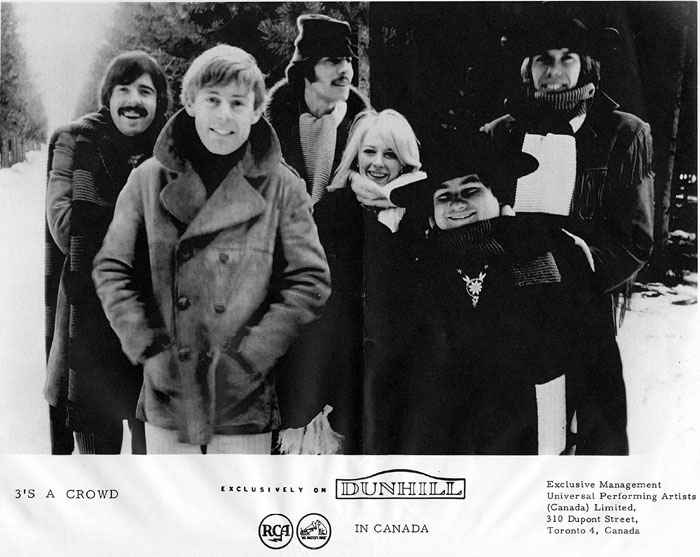
The vibrant music scene that existed in Canada during the ‘60s has rarely been given the exposure it merits. Undoubtedly, the Canadian music industry must shoulder much of the blame. Not only did it actively discourage the flowering of homegrown acts, but the fact that American-based, Canadian artists like Neil Young, Joni Mitchell and The Band have proven they are the equal of their American and British contemporaries, underlines what can be achieved with industry support. For those who chose not to base themselves in the US, the prospect of international acclaim was slight, which may explain why the folk-rock outfit 3’s a Crowd have remained an obscurity outside Canada.The original 3’s a Crowd line-up was formed in Vancouver in the summer of 1964, when folk singer, guitarist and comedian Brent Titcomb (b. 10 August 1940, Vancouver, British Columbia) joined forces with singer Donna Warner (b. 23 May 1946, Edmonton, Alberta).
Of the two, Titcomb had the more established career, having spent the best part of the early ‘60s frequenting the city’s folk clubs, where he combined traditional folk songs with a comedy routine. (On several occasions he would book himself at two clubs on the same night; after performing as a folk singer at the first, he would then drive to the next to perform as a comedian, often under the names “Uncle Roy Plain” and “Dr Mezner”.)
Titcomb’s stage act soon attracted the attention of performer Oscar Brand, and in early 1964 he was invited to perform at the world famous Calgary Stampede, which is where he befriended Donna Warner, currently singing with The Kopala Trio. Warner’s musical accomplishments were somewhat different to Titcomb’s, having spent much of her youth singing in a number of choirs in her native Edmonton. (Her grandfather incidentally, had been a choirmaster in Glasgow.) The pair nevertheless, had a lot in common (a mutual love of folk music and a “very quirky sense of humour”) and made arrangements to meet up in Vancouver once Warner had finished high school that summer.
The Calgary gathering proved to be notable in more ways than one, however. During a visit to the city’s premier folk den, the Depression, Titcomb and Warner were introduced to singer/songwriter David Wiffen (b. 11 March 1942, Sydenham, Kent, England), who would feature prominently in 3’s a Crowd’s story in later years. A love of folk music again provided a common bond but their paths ultimately diverged as Titcomb and Warner duly headed west to Vancouver.
Once there, the pair quickly became regulars at Les Stork’s Bunkhouse, a coffeehouse where Warner worked as a waitress and performed on “open mike” nights with Titcomb. On a number of occasions, guitarist Trevor Veitch (b. 19 May 1946, Vancouver, British Columbia) joined in, and his proficiency on the instrument so impressed them that the three of them decided to form a group. They also took part in after-hours get-togethers with local and visiting musicians in what were essentially “kitchen jams”.
The newly established trio quickly set about grooming their act, which mixed comic routines with the folk songs of the day. Around January of the following year, the group officially debuted at the Bunkhouse coffeehouse under the oddly titled moniker, The Bill Schwartz Quartet. Apparently the name was Titcomb’s idea – the group apologised all weekend for Bill’s absence until the very last song of the last set on the last night when Titcomb’s high school buddy “King Anderson” showed up on stage wearing an eye patch and joined in on harmonica.
Understandably the club owners were not amused, after all they had been led to believe that a quartet would be playing and had paid for one accordingly. A new name was deemed necessary, and on hearing the group’s conversation, Anderson pitched in: “Two’s company and three’s a crowd.” The band adopted the name immediately.
The first reference to the trio’s new name appears to have been in June 1965, when the group was pictured on the front of the local TV Times. The band’s sudden rise to fame was no doubt due to a series of shows at the Ark two months earlier, where it had performed with local jazz double bass player Danny Schultz. (The group’s performance caused quite a stir and was impressive enough in fact for the organisers to record some of the shows.)
The next logical step was to move lock, stock and barrel to Toronto, the epicentre of the Canadian music scene, and in a propitious move, the group sent a demo tape to Sid Dolgay, formerly a member of Canada’s premier folk group The Travellers. Dolgay had recently formed his own management company, Universal Performing Artists (UPA), and was on the lookout for new talent. Suitably impressed by the group’s tape, he invited them to Toronto to perform some engagements and shortly afterwards signed the trio.
Although they didn’t know it at the time, Toronto would become 3’s a Crowd’s home for the next three years. While there the group would become a regular fixture at the city’s renowned Riverboat club and a popular live attraction on the folk circuit.
The best part of late 1965/early 1966 was spent touring the length and breadth of the country, largely as a trio (the group could rarely afford the luxury to pay supporting musicians). Nevertheless on a few occasions, former Bad Seeds bass player Brian Ahern (later Emmylou Harris’s producer and second husband) joined the band to add a little muscle.
By the spring of 1966, however, 3’s a Crowd’s following was such that a full-time bass player was a distinct possibility. The scene was changing too, and the impact of The Byrds and Bob Dylan’s new brand of “electric folk” couldn’t be ignored.
Consequently, the group enlisted the services of bass player Kenny Koblun (b. 7 May 1946, Winnipeg, Manitoba) during early March. A former member of Neil Young’s high school band The Squires (and later Four To Go), Koblun would prove to be a transient musician in the 3’s a Crowd story. His various comings and goings were marked by personal problems, and in many ways his relationship with the band was not that dissimilar to his contemporary in Buffalo Springfield, Bruce Palmer.
The Buffalo Springfield in fact provided a useful link. Koblun’s relationship with that band would remain close, and within a month of joining 3’s a Crowd, he was tempted away by an offer to join Stephen Stills and Richie Furay in an embryonic version of that band. (Koblun and Young had befriended Stills the previous year, when Stills’s group The Company shared the bill with The Squires.)
As Koblun told rock historian John Einarson: “Stills called me and told me that I should come down to California to join his band.” Which is what Koblun did, but the arrangement proved to be brief: “I spent a week with Stills and Furay but nothing was happening. I had to make a decision. I had twenty dollars in my pocket. Either spend it on food and stay with Stills in California, or spend it on a taxi fare to LA airport and the manager from 3’s a Crowd was going to pay for my ticket back to Toronto. So that was what I did.” (Unknown to everyone concerned, Young and Palmer were on their way to LA to meet up with Stills and Furay as Koblun was on his way out.)
Back with 3’s a Crowd, Koblun lasted long enough to appear with the group for a taping of the highly-rated TV programme The Juliette Show, before dropping out after an engagement at the Raven’s Gallery in Detroit in mid-April.
In his place the group enlisted bass player Comrie Smith (b. 29 September 1945, Toronto, Ontario), who ironically also shared a Neil Young connection. Smith and Young had in fact been high school friends at Lawrence Park Collegiate Institute in Toronto from 1959-1961.
When The Squires relocated to Toronto in mid-1965, they spent a brief period playing together and made some rough demos of Young’s songs in Smith’s attic. After Young moved on, Smith took some of his songs to Arc Records but nothing came of it at the time. However, some of these songs, including “Casting Me Away From You”, “Hello Lonely Woman” and “There Goes My Babe” have finally surfaced on the first installment of Neil Young’s Archives series.
Smith’s enlistment brought stability to 3’s a Crowd and in the latter half of 1966 the band was awarded its first Juno (the Canadian equivalent of the Grammy) for best folk group of the year, a distinction it would also enjoy the following year.
The Juno award undoubtedly raised the group’s profile and in September of that year 3’s a Crowd won a short-term deal with Epic Records in New York. Initially, the label promised to record four singles but in the event only one was completed at the first session with Toronto producer Ben McPeek and New Yorker Bob Morgan. Drums, bass and a horn section were added later to fill out the sound.
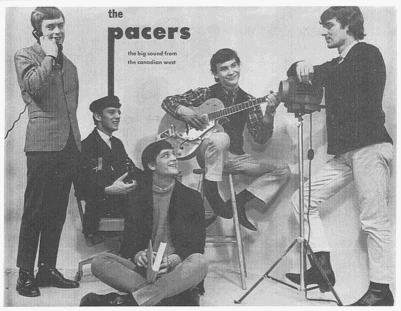
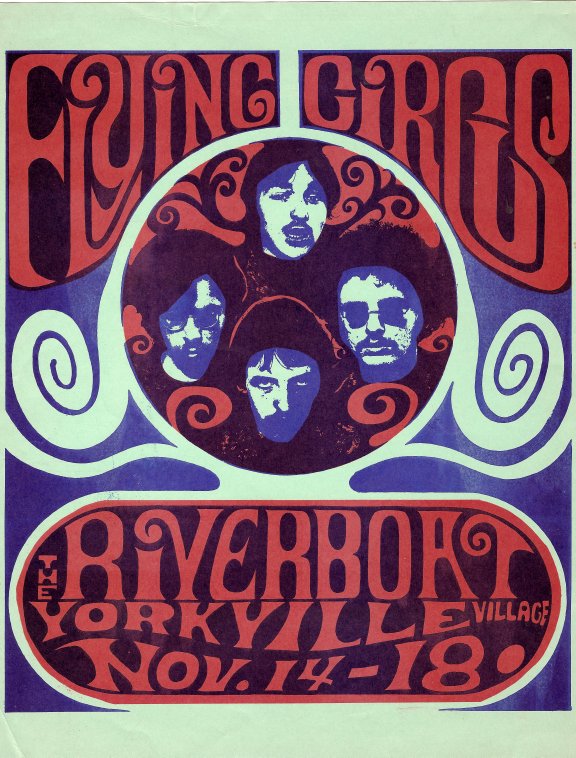
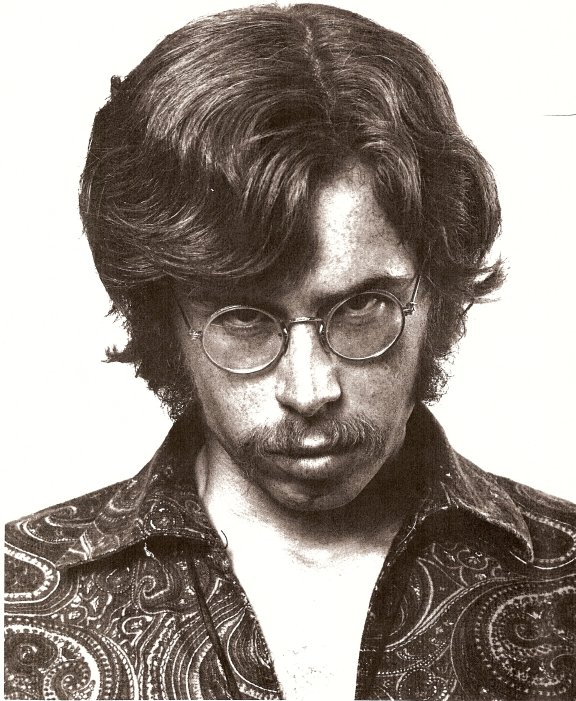
The result was the catchy folk-rocker “Bound To Fly” written by black American songwriter Len Chandler, coupled with a cover of Gordon Lightfoot’s “Steel Rail Blues”. The single was given a Canadian release on 24 October, and (according to Billboardin January 1967) was even issued in Britain, making it the band’s sole UK outing and a rarity at that. (The single finally peaked at #34 on the Canadian RPM chart and proved to be the group’s biggest hit.)By the time the single appeared Koblun was back in the fold, having played with American singer Carolyn Hester in the interim. His second stint, however, barely lasted out the year. On this occasion it was a desperate call from his old friend Neil Young, which led to his third departure in less than a year.
In early January, while Buffalo Springfield were performing in New York, Canadian Bruce Palmer had been arrested on marijuana charges and summarily deported. The others headed back to LA but with tour dates to honour, an immediate replacement was required. Young naturally suggested his former cohort – and it certainly helped that Koblun was familiar with Stills and Furay. It seemed a perfect arrangement and yet perhaps predictably, Koblun’s tenure with the group proved to be short-lived. While Koblun was under the impression that he was joining the band, the others merely thought he was “filling in”, until Palmer sorted out his problems and returned. After only three weeks, Koblun was asked to leave and returned somewhat despondently to Toronto.
3’s a Crowd meanwhile, re-enlisted Comrie Smith, who appears to have acted as a sort of “all-utility man” for whenever Koblun was absent. Amid all this activity, the band returned to New York to record a follow-up single with A&R man Ted Cooper. The result, the comedy single “Honey Machine” c/w “When The Sun Goes Down”, was quickly disowned by the trio, who fell out with Epic over the label’s marketing of the band. (The label saw the group as a sort of novelty/comedy act, which was not the image the trio wanted to project.) In the end, 3’s a Crowd severed their ties with Epic and the single thankfully died a quick death.
Back in Canada, 3’s a Crowd resumed gigging and at Ottawa’s Le Hibou coffeehouse (most likely for shows between 28 March-2 April) reunited with David Wiffen, who was singing in a local group called The Children.
His next move was to join a local beat group called The Pacers, who were soon offered a recording deal in Montreal. Trekking east, the group soon discovered that the promise of a deal had been a smokescreen; the company merely looking for an excuse to milk the group for all its worth. Wiffen and the others were subsequently obliged to slog it out on the local club scene, which at the time was very exhausting (8pm-3am, seven nights a week!). A lone single on RCA Victor – “I Want You Back” c/w “Windjammer”, turned up in late 1965 but it’s not clear whether Wiffen appears on it.
The others soon lost heart and returned home, while Wiffen moved to Ottawa, after hearing about the folk scene based around the Le Hibou coffeehouse. Before long he was invited to join the city’s premier folk-rock group, The Children, which at that time featured aspiring singer/songwriter Bruce Cockburn (b. 25 May 1945, Ottawa, Ontario) and drummer Richard Patterson (b. 20 September 1944, Ottawa, Ontario), both of whom would feature greatly throughout his career. Wiffen and Patterson struck up a rapport and when 3’s a Crowd enquired about Wiffen’s services, he was keen to champion Patterson as a drummer.
His erstwhile colleague’s background was also distinguished. During the early ‘60s Patterson had played in Canada’s answer to Cliff Richard & The Shadows, The Esquires, who incidentally were one of Neil Young’s favourite groups. The Esquires had cut a number of singles for EMI/Capitol Records during the early to mid-‘60s. The Esquires had also produced Canada’s first professional music video and been voted Top Pop Vocal & Instrumental Group of 1964.
The addition of Wiffen and Patterson in April 1967 was to all intents, the turning point in the band’s career. Patterson’s solid drumming strengthened the group’s overall sound, while Wiffen’s attractive baritone (not dissimilar to Fred Neil’s), provided an interesting counterpoint to Warner’s voice and boosted the group’s overall appeal immeasurably. They also brought with them much of The Children’s material, which by the standards of the day was excellent.
With Wiffen and Patterson aboard, the “expanded” group made its debut on the popular afternoon show Take 30 where, according to Patterson, host Paul Soales spent most of the interview asking Wiffen and himself why they had joined an established act instead of forming a new band of their own.
The exposure generated by the show nonetheless helped 3’s a Crowd to break out of the Canadian market. An important engagement at Steve Paul’s prestigious New York club, the Scene from 15-21 May was quickly arranged, while the band also made regular visits to the Back Porch Club in Columbus, Ohio. Another important showcase from that period was the annual Mariposa Folk Festival (Canada’s answer to Newport), held at Innis Lake near Toronto on 11-13 August.
The festival, featuring the cream of Canada’s folk community, reached a watershed in its history that year; 1967 was not only the last year before the festival moved to its present location on Toronto Island, but was also the first to feature electric instruments. The inclusion of local groups 3’s a Crowd and Kensington Market reflected this growing acceptance of “electric folk”, and was an acknowledgement of the folk-rock scene emerging in Canada.
As important as Mariposa was, however, it would be eclipsed that summer by the world famous Expo Exhibition being staged in Montreal. 3’s a Crowd had been spotted performing at the Riverboat by one of the entertainment co-ordinators for the Ontario Pavilion and were subsequently allocated a slot at the Pavillion in late August and early September.
Prior to this, the group concluded a two-week engagement at the Le Hibou coffeehouse (27 July-6 August), after which Smith left to make way for a returning Ken Koblun, who no doubt was in a better frame of mind. In the intervening months since leaving Buffalo Springfield, Koblun had been playing with Elyse Wienberg’s O.D Bodkins and Company, but was eager to re-establish his position in his former group. For 3’s a Crowd, Montreal’s Expo ’67 was the premier event of the summer and the one that ultimately bagged the all-important record deal.
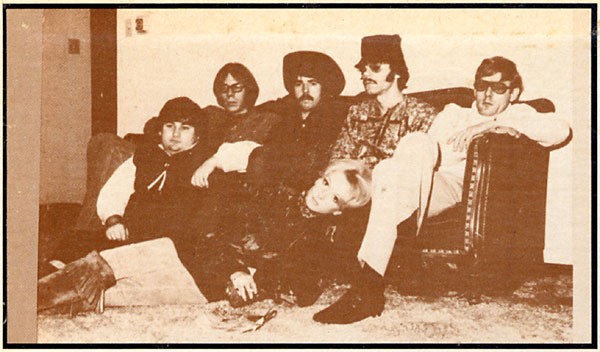
In a fortuitous twist of fate, a friend in LA had asked Warner’s boyfriend (at that time one of the promoters of Toronto’s first mini outdoor music festival) to accompany Cass Elliot and Denny Doherty of The Mamas and the Papas on a visit to Expo. What’s more, he also asked him to make sure they had everything they desired. Warner’s man not only kept his word, but also ensured that Elliot and Doherty were escorted to the Pavilion as 3’s a Crowd took the stage.Though Doherty clearly enjoyed his old friend’s group, it was Elliot, who, according to Patterson “saw a possible career opportunity for herself as a producer” for 3’s a Crowd. Enthused by their performance, she contacted Jay Lasker, President of ABC Dunhill, to rave about her new find and Lasker asked for a demo tape to be forwarded to him immediately.
For the purposes of recording the demo, Harvey Glatt (who Patterson says “owned most of the publishing of the new songs the group was performing” and had managed The Esquires and The Children) hired out Bell Studios in New York in mid-September. He also commissioned his friend Rick Shorter (The Paupers’s debut album being among his credits) to produce the three songs. While in New York, the band continued to work showcase dates, before returning to play at the Canadian Pavilion Feature stage at Expo ‘67.
Then finally, after what seemed a lifetime, a call came through to Sid Dolgay that the group was expected in Los Angeles as soon as possible to sign a deal and begin recording. Abetted by David McLeod, previously the talent co-ordinator and liaison for the Ontario Pavilion, and now acting as the band’s road manager, 3’s a Crowd flew out to LA for a month’s work in mid-October.
For Patterson in particular the group’s arrival in LA brings back fond memories: “Dunhill sent a couple of limos direct to the plane’s staircase and a photographer covered the arrival for the record label. As a matter of fact part of the arrival was…a photo shoot where we had to parade up and down the staircase a couple of times, and cavort around the tarmac waving our hands to the then non-existent cheering fans.”
The group was then driven to a small but comfortable Beverly Hills hotel round the corner from Dunhill’s offices, which according to Patterson “had a wonderful in-house restaurant where we non-suntanned northerners could order a large glass of freshly squeezed orange juice for a mere fifty cents.”
Sessions began soon afterwards at Studio 3, Western Recorders on Sunset Boulevard with engineer Chuck Britz assisting Elliot. However, as Patterson recalls, after a week in the studio, “Cass lost interest in the every day of it” and by end of the week, Dunhill staff producer Steve Barri (PF Sloan’s writing partner) was in charge. (When the album came out though Elliot was credited as co-producer, perhaps in recognition of the fact that she had discovered the band.)
The first week was also notable for the presence of top session drummer Hal Blaine, who was brought in, according to Patterson, to “size my talent up”. Patterson didn’t know it but in those days the majority of sessions with bands included the use of top studio drummers sitting in with the group. Patterson needn’t have worried though; Blaine was bowled over by his playing and offered the use of his equipment stored in the studio’s basement! As the sessions progressed, the band also found time to play a few local dates including a performance at the student union, UCLA on 20 October; a photo of which found its way onto the back cover of their album later in the year.
Photographs from 3’s a Crowd’s arrival at the airport plus a group visit to Western Costume Company were also slated for the album’s cover and inside collage. In the latter case the band spent a morning looking at various catalogues of photos in the company’s inventory before choosing their favourites. In the end, Veitch decided on a white set of tails once worn by Fred Astaire, while Warner picked one of Maid Marion’s dresses from a Robin Hood film. Titcomb’s choice was a First World War fighter pilot’s uniform. Koblun, on the other hand, dressed in an old policeman’s outfit, while Patterson chose a 1930s full-piece bathing outfit and Wiffen dressed as a New York Irish boxing coach! A final photo taken at Elliot’s house (with 3’s a Crowd decked out on her sofa) after a dinner party held for the band one evening was also picked out for use.
Back in Toronto, the band embarked on a frenzy of activity, the highlight of which, was a television special for the CBC (Canadian Broadcasting Company) called Our Kind Of Crowd. The show, aired from coast to coast, boosted the group’s credentials and also provided a platform for their chosen guests, comedian Richard Pryor and up and coming singer/songwriter Joni Mitchell; both relatively unknown at the time but soon destined for greater things.
Unfortunately, the same could not be said about 3’s a Crowd; although the TV show was clearly a great success and bode well for the future, the group’s career was about to grind to an unwelcomed halt.
Ironically, the recent success proved to be the group’s ultimate undoing. The pressures of touring were as Patterson concedes “taking its toll on both Donna and Kenny”, and following a stint at the Riverboat during December, Koblun quit for the fourth and final time, suffering from nervous exhaustion.
He subsequently returned to Winnipeg and enrolled on a computer course at the city’s university. In the early ‘70s he briefly ventured back into music, playing with a few local groups, before trading in his bass for a career in computers. He currently lives in San Francisco.
In his place 3’s a Crowd recruited bass player Wayne Davis (b. 28 April 1946, Toronto, Ontario) from R&B outfit Bobby Kris and The Imperials, and before that Just Us.
As Patterson reveals, however, Koblun was not the only member to succumb to the pressures on the road. Donna Warner also struggled to cope with the heavy workload and on a number of occasions was too ill to perform. During the group’s Expo stint the previous summer, Ottawa-based singer Colleen Peterson (b. 14 November 1950, Peterborough, Ontario) had ably covered for Warner and would continue to do so at intervals throughout early 1968. In this way Peterson’s role bore an uncanny resemblance to Comrie Smith’s earlier in the year.
Peterson, another of Harvey Glatt’s protégés was a respected singer on the folk circuit and in 1967 had won a Juno award for most promising new vocalist. More importantly, she was well acquainted with the band’s repertoire, having been closely associated with The Children. She was, as Patterson points out, “a natural choice”.
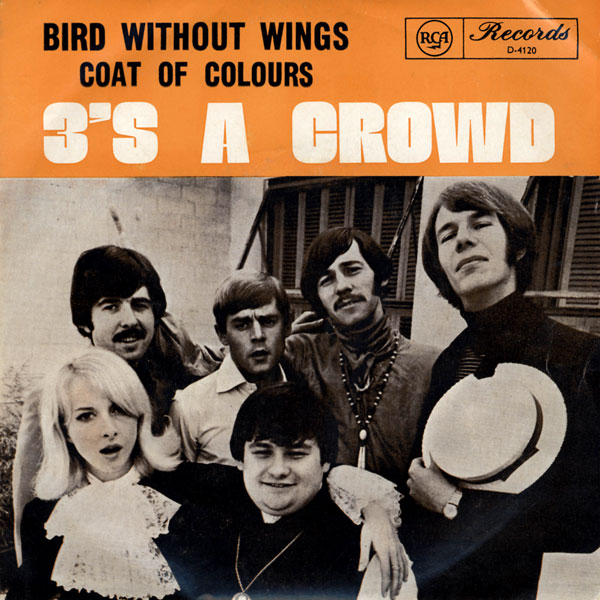
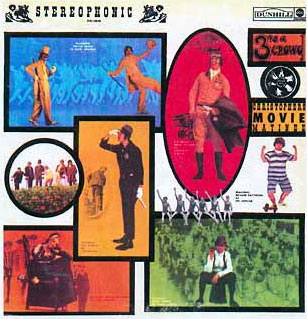
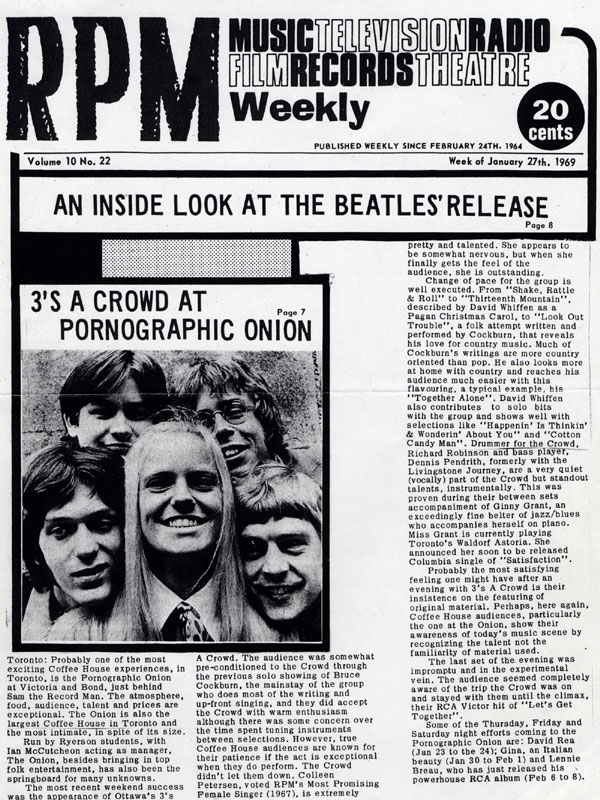
3’s a Crowd spent most of early 1968 showcasing the album, which had yet to be given a Canadian release. The “expanded” group’s debut single, a cover of Bruce Cockburn’s catchy “Bird Without Wings” was issued in early February (and even gained an Australian release!). Its relative success (peaking at #61 on the RPM chart) coincided with a tour of Western Canada, featuring memorable dates at the Simon Fraser University on 28 February and the Retinal Circus in Vancouver from 1-2 March.The band then headed back to the US West Coast for a series of dates at the Ice House in Glendale from 5-17 March supported by folk singer couple Jim & Jean. Patterson remembers Neil Young showing up in his Austin Mini Cooper one afternoon, perhaps hoping to catch his old buddy Ken Koblun. Young subsequently invited the group to an informal jam at Stephen Stills’s girlfriend’s house in Topanga Canyon a few days later, and the events that followed were to become the stuff of legend.
As Patterson recalls the car (containing Jim & Jean, Titcomb, Warner and himself) was stopped by the police on route to the party and its occupants presented with a fait accompli; either reverse and go home or carry on and be arrested with the other party goes at the house. (The police had just raided the house and in the ensuing drama three members of the Buffalo Springfield and Eric Clapton had been arrested on suspected drug charges.) Patterson and company returned home, narrowly avoiding one of rock music’s most famous drug busts.
In retrospect the Topanga Canyon episode signaled the end of The Buffalo Springfield, and 3’s a Crowd’s career was about to take a similar path. Back in Canada, the group was joined by members of the Toronto Symphony Orchestra for a memorable performance at Massey Hall, where the group debuted the album in its entirety with full orchestration, an act never to be repeated. However, Warner’s declining health could not be ignored and following some final dates at Toronto’s Friars Tavern in early May, she left the group just as the album Christopher’s Movie Matinee hit the shops.
The record, though far from being a long lost classic, is still a wonderful collection, which holds up surprisingly well today. The highlights include the sprightly folk-rockers “Drive You Away”, (penned by Wiffen), and “Bird Without Wings”, plus the melancholic ballad “Cotton Candy Man”, the latter also emanating from Bruce Cockburn, who contributed two other songs to the collection. The album’s real gem (as far as this listener is concerned), however, is the band’s haunting version of Bill Hawkins’s (of The Children) “Gnostic Serenade”, which shows how gifted a singer Wiffen is.
At the time, the record was largely ignored, although Billboard did run a brief review earlier in the year: “The music is good, alive and invigorating. It won’t take long for this group to make a solid dent on the best seller charts.”
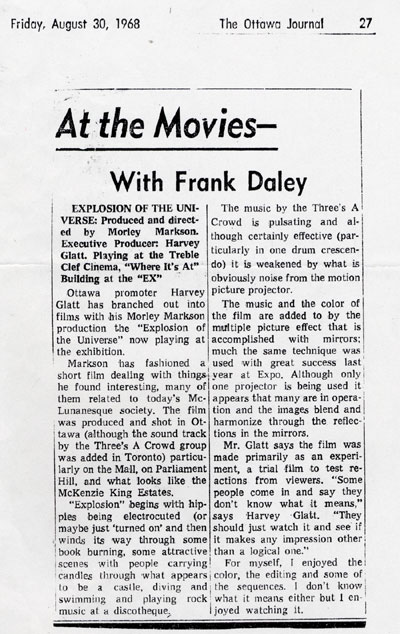
And perhaps it would have had there been a group to support it, but as Patterson points out, when Warner left, Titcomb and Veitch lost interest in the band and were not prepared to put things on hold while she recuperated.But if Titcomb and Veitch were no longer in the picture, there were still commitments to be honoured; Sid Dolgay’s two investors in the group – Harvey Glatt and Toronto film producer Sid Banks were intent on pushing the band. (There was outstanding debt to be paid off and a recently issued album to promote.)
As a result a new version of the band was formed in Ottawa during the summer comprising David Wiffen and Richard Patterson alongside some old and familiar faces.
Former Children members Bruce Cockburn and Sandy Crawley (b. 7 December 1947, Ottawa, Ontario), the son of independent filmmaker Budge Crawley, who made the rock documentary Janis, were drafted in alongside Colleen Peterson.
The new group was completed with bass player Dennis Pendrith (b. 13 September 1949, Toronto, Ontario), who had been in Cockburn’s last band Olivus, and before that had played with Simon Caine & The Catch, Luke & The Apostles and the short-lived group Livingstone’s Journey.
In the midst of all these changes, RCA Victor belatedly released a second single from the album, a cover of Dino Valenti’s “Let’s Get Together” backed by “Drive You Away”, which stalled at #70 on the RPM charts.
The new line-up quickly returned to the road, spending the best part of the summer supporting The Turtles and Gary Puckett & The Union Gap on their Canadian dates.
During this period 3’s a Crowd found time to record a recent Bruce Cockburn composition “Electrocution of The Word”, and Glatt subsequently produced a video to accompany it, which ran at Ottawa’s Teen Pavilion as part of the Canada Exhibition.
Amid all this activity, 3’s a Crowd were hired by Sid Banks to provide the youth element to a new TV series that he had been commissioned to produce called One More Time, hosted by Broadway actor/singer Gilbert Price. Twenty-six episodes were recorded for the first series during the late summer and the band were asked to perform two/three songs per show. (The majority of the music on the show was Broadway hits and guest slots by a few other pop groups, but it was one way for Banks to recoup some of his investment in the band.)
The series was a reasonable success and was renewed for another season with a second batch of taping in the winter. Banks, however, felt that the group’s songs were, according to Patterson, “too alternative for the audience” and pitched the idea of “putting a pop arrangement to some of the top Broadway tunes”. 3’s a Crowd were understandably reticent about such an undertaking but in the end came up with some rather unusual renditions of songs such as “Mack The Knife”.
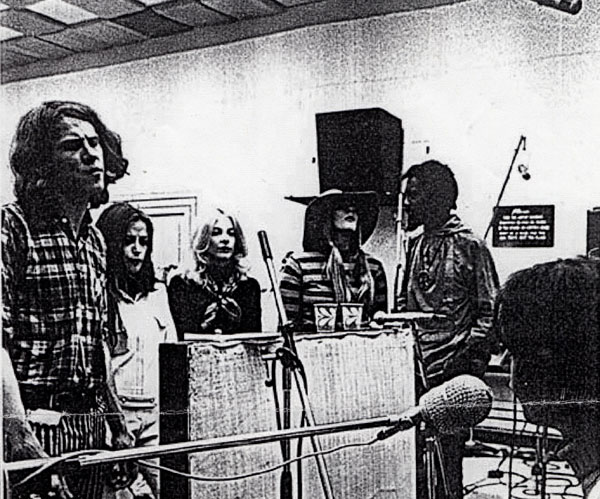
After the TV series ended in early 1969, the band was offered a spring tour of the US college and university circuit. Crawley, who was more intent on pursuing an acting career opted out leaving the others to fulfil what essentially were 3’s a Crowd’s final dates.The last engagement at Columbia in South Carolina was a low-key affair and summed up the group’s career in a nutshell. They had never been a highly touted band and yet the degree of talent within the group, when looked at retrospectively, would suggest that they deserved a lot more recognition than they did.
Since the group’s final split, the band’s members have, collectively, produced a remarkable body of work. Cockburn undoubtedly has maintained the most visible profile; with close to thirty albums, and a top thirty US hit in “Wondering Where The Lions Are” to his credit, he has produced a wealth of material that surpasses many of his (better-known) ‘60s contemporaries.
Titcomb also emerged as a solo artist (producing three albums for small Canadian labels), but is perhaps best known for his songwriting skills. Canada’s popular country singer Anne Murray recorded many of his songs, including “Sing High, Sing Low” and “I Still Wish The Very Best For You”. Besides this, Titcomb has also made a habit of cropping up in the most unlikely places. He made a cameo appearance in the popular TV series Due South, and has also done voice-overs for cartoon programmes The Care Bears and Clifford The Dog. If that weren’t enough he has produced song jingles for radio and television, appeared in a TV commercial for Canadian Tire and been featured on a commemorative postage stamp acknowledging the corporation’s 75th Anniversary! His son Liam Titcomb has also established himself as a singer/songwriter of note.
Peterson, who died of cancer in October 1996, also found success after leaving 3’s a Crowd. Her first notable recording was with the New York group Taking Care of Business, who released a lone album, Open For Business on Traffic Records in 1969. In the mid-‘70s she became a popular country singer in Nashville and recorded a string of albums for Capitol. She later returned to Canada and enjoyed a hit with a cover of Patsy Cline’s “Crazy”. Shortly before she died Peterson was involved in the first LP by Sylvia Tyson’s band The Quartette.
Her predecessor Donna Warner kept a low profile but did make a guest appearance on Jay Telfer’s unreleased album Perch in mid-1969, singing backing vocals. She subsequently appeared on an album with Tommy Banks Century II productions in the early ‘70s and currently resides in Edmonton where she sings in a local choir at a local cancer care facility.
Veitch, like his erstwhile colleagues also found belated success. For a while, he became American singer/songwriter Tom Rush’s right-hand man, but when the duo parted in the mid-‘70s he headed for LA where he has lived ever since. Veitch is perhaps the most unlikely member of the group to find success as a songwriter, and yet no one could quite have foreseen the level of success that was generated from Laura Brannigan’s “Gloria” and Toni Basil’s “Mickey”, both co-penned by Veitch. He has also found a niche for himself as a session player, appearing on albums by artists as diverse as Pink Floyd, Madonna, Frank Sinatra and Luther Vandross. And then there is also his work on film soundtracks, such as Pretty Woman and Top Gun.
Dennis Pendrith also followed the session path. One of Canada’s top session musicians, he also plays with The Bebop Cowboys, while Patterson recorded a lone single with Canada Goose, a cover of Jackie Wilson’s hit “Higher and Higher” for the New York based Tonsil Records, which reached #44 on the RPM charts. He subsequently joined forces with Tom Rush and Ian and Sylvia Tyson’s Great Speckled Bird before working for The Canadian Broadcasting Company for 16 years.And finally there is David Wiffen, who, despite a loyal following in Canada, has remained something of an obscurity elsewhere. That is a huge injustice as his solo work is easily comparable to many of his oft-cited contemporaries. Like Nick Drake and David Ackles, Wiffen has only produced a handful of recordings, yet that has not prevented his songs from being widely covered by many highly respected artists.
Following the break up of 3’s a Crowd, Wiffen paid his way down to Oakland, California to record his second solo album after bagging a recording deal with Fantasy Records. The label – best known for Credence Clearwater Revival – arranged for Wiffen to work with former Youngbloods guitarist Jerry Corbitt, and although Wiffen was able to invite along Sandy Crawley, most of the players were unfamiliar to him. This caused some problems as the record was later finished without his involvement and the master tapes were reportedly damaged. Not only that but only promotional copies were made available in the US. The record did see a Canadian release, but copies are now extremely scarce, and the record has only been re-issued (by Italian label Comet Records’ subsidiary Akarma Records), despite containing his best known songs “Drivin’ Wheel”, “More Often Than Not” and “Mr Wiffen”.
The distribution problems in the US were certainly frustrating but at least Wiffen had the consolation that his work was being covered by the likes of Tom Rush, Roger McGuinn, Ian & Sylvia Tyson, Jerry Jeff Walker, Eric Anderson and Harry Belafonte.
Wiffen’s influence also is evident in more contemporary artists; “Drivin’ Wheel” has become an integral part of The Cowboy Junkies’ live sets. This renewed interest in his work has led to the recording of his first solo album since 1973’s highly acclaimed Coast To Coast Fever album which saw Wiffen collaborate with former 3’s a Crowd members Bruce Cockburn and Dennis Pendrith. His latest album, which is entitled South of Somewhere, includes a number of reworked versions of Wiffen’s “classic” songs plus some new material.
3’s a Crowd’s career meanwhile may finally receive the recognition that it deserves. Richard Patterson has been busy working on a compilation album mixing the band’s album and early singles with later live material, which has previously been unreleased. The CD compilation has yet to see the light of day.
Nevertheless, the respect given to group members Bruce Cockburn and David Wiffen mean that the band will always be held with affection by those who witnessed the group play in Canada during the mid-late ‘60s.
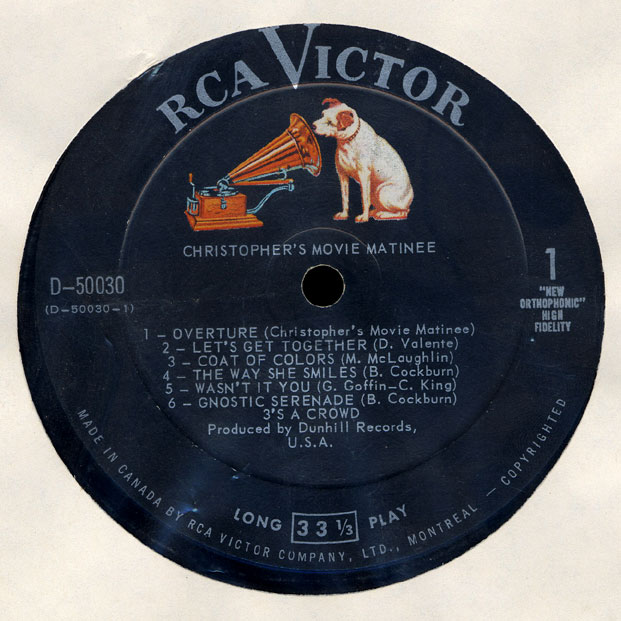
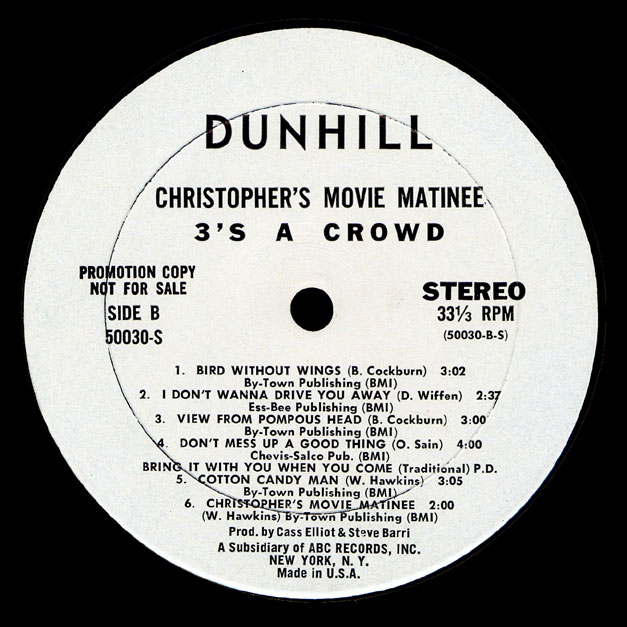
Recordings
45 Bound To Fly/Steel Rail Blues (Epic 5-10073) 1966
45 Honey Machine/When The Sun Goes Down (Epic 5-10151) 1967
45 Bird Without Wings/Coat of Colours (RCA Victor 4120) 1967
45 Bird Without Wings/Coat of Colours (Dunhill D-4120) 1968 (US release)
45 Let’s Get Together/Drive You Away (RCA Victor 4131) 1968
45 Let’s Get Together/Drive You Away (Dunhill D-4131) 1968(US release)
LP Christopher’s Movie Matinee (RCA Victor DS-50030) 1968 (Canadian ‘mono’ copy)
LP Christopher’s Movie Matinee (Dunhill DS-50030) 1968 (US release)Advertised gigs
November 14-20 1965 – 4-D, Regina, Saskatchwan
November 21-December 4 1965 – Esquire Club, Saskatoon
December 12-23 1965 – Guiseppe’s, Edmonton
January 6-19 1966 – Brass Rail, Halifax, Nova Scotia
March 1-6 1966 – Le Hibou, Ottawa
March 17-20 1966 – 4-D, Regina
March 29 1966 – Riverboat, Toronto
April 5-10 1966 – Riverboat, Toronto
April 19-21 1966 – Raven’s Gallery, Detroit
April 23-28 1966 – Riverboat, Toronto
February 24-26 1967 – Le Hibou, Ottawa
February 28-March 5 1967 – Le Hibou, Ottawa
March 28-April 2 1967 – Le Hibou, Ottawa
May 15-21 1967 – Steve Paul’s The Scene with Dianne Brooks, Eric Mercury and The Soul Searchers
July 27-30 1967 – Le Hibou, Ottawa
August 1-6 1967 – Le Hibou, Ottawa
August 11-13 1967 – Mariposa Folk Festival, Toronto
August 17-September 8 1967 – Expo ’67 Exhibition, Ontario Pavilion, Montreal
September 1967 – Steve Paul’s The Scene, New York with Lothar & The Hand People
October 2-9 1967 – Canadian Pavilion, Expo ‘67 Montreal
October 20 1967 – Student union, UCLA, Los Angeles
November 11 1967 – Neil McNeil’s High School, Toronto
November 13-25 1967 – Granny’s, Walker House Hotel, Toronto
December 2 1967 – Ohio State University, Columbus, Ohio
December 19-24 1967 – Riverboat, Toronto
January 1968 – Lawrence Park Collegiate, Toronto
February 28 1968 – Simon Fraser University, Vancouver
March 1-2 1968 – Retinal Circus, Vancouver
March 5-17 1968 – Ice House, Glendale, California with Jim & Jean
March 29 1968 – Massey Hall, Toronto
April 22-May 4 1968 – Friars Tavern, Toronto
May 14-18 1968 – Le Hibou, Ottawa
November 19-24 1968 – Le Hibou, Ottawa
January 16-18 1969 – Pornographic Onion, Toronto
The article would not have been possible without the generous help of John Einarson and particularly Richard Patterson, who interviewed the band members. Thanks also to Graham Wiffen, Donna Warner, Sandy Crawley, Brent Titcomb and Trevor Veitch for their input. Thank you to Ivan Amirault for the scans from RPM.
Copyright © Nick Warburton. All Rights Reserved. No part of this article may be reproduced or transmitted in any from or by any means, without prior permission from the author.
Email: Warchive@aol.com
US promotional sleeve
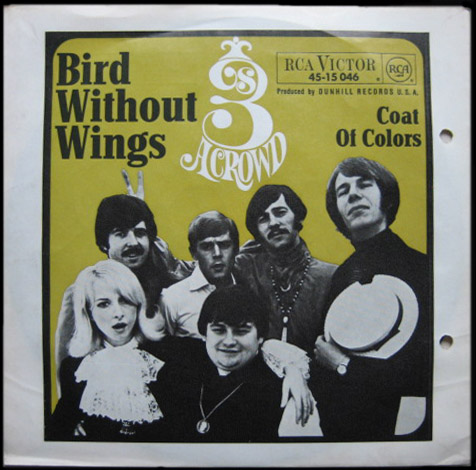
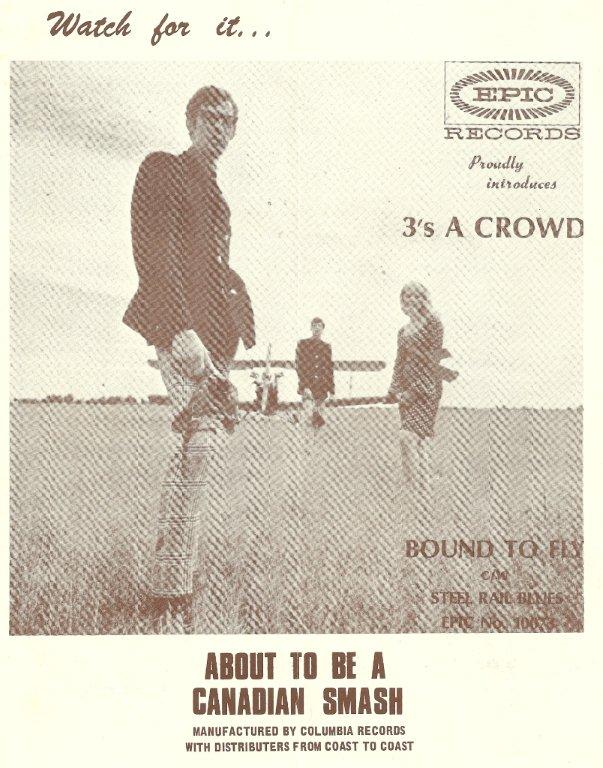
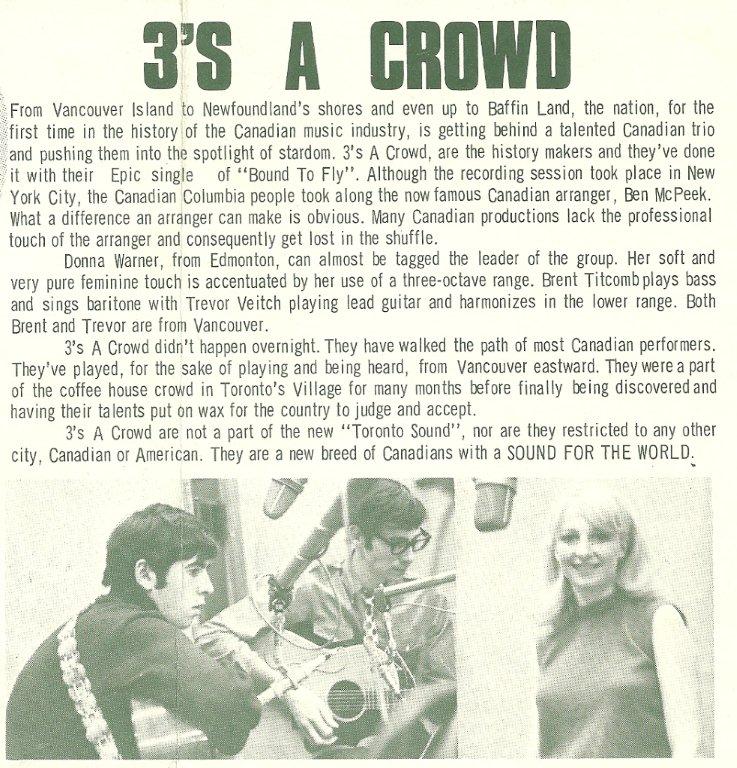
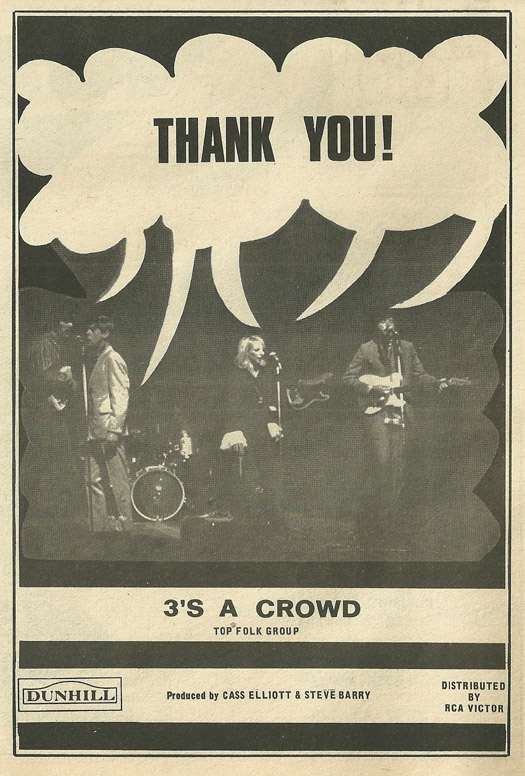
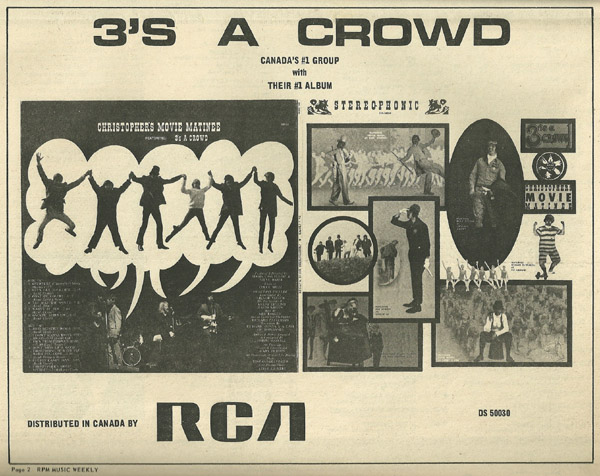

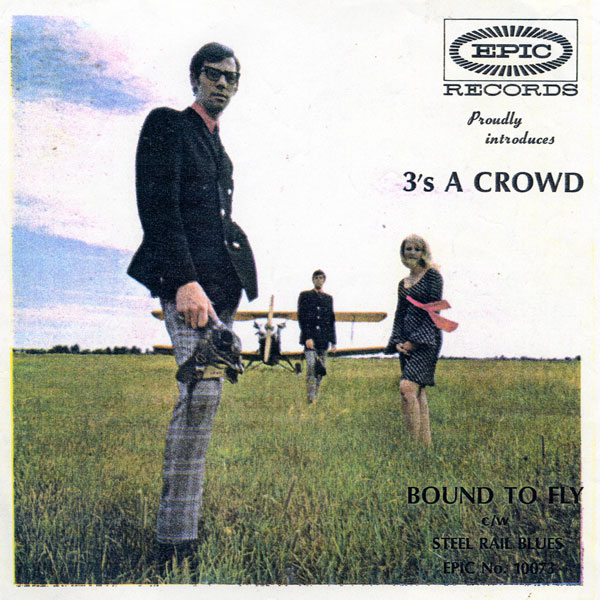
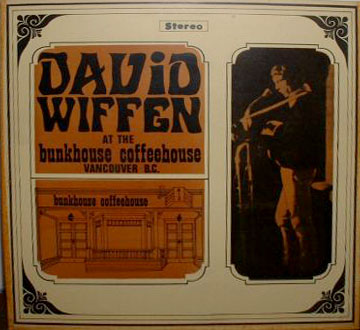
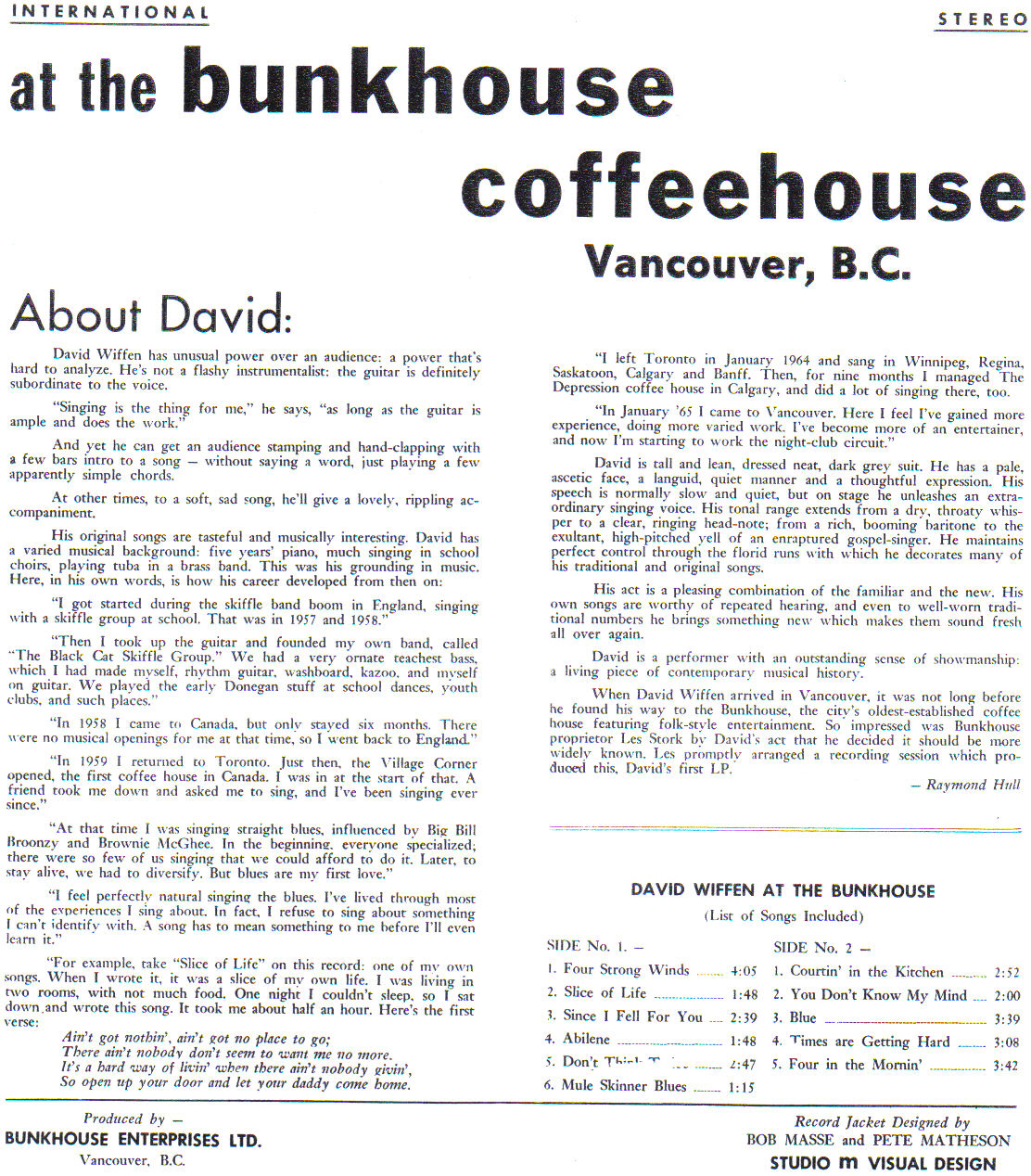
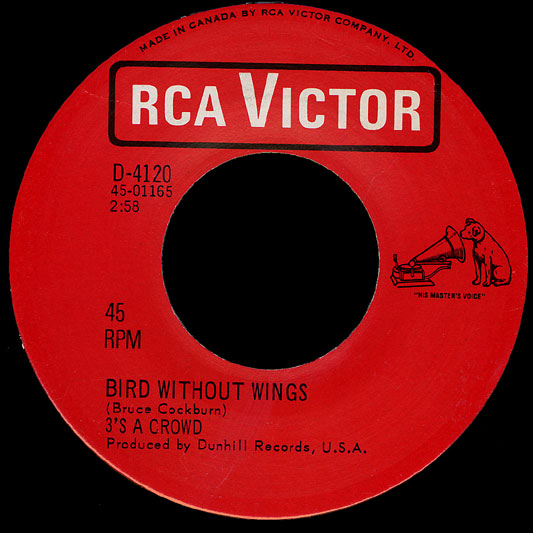
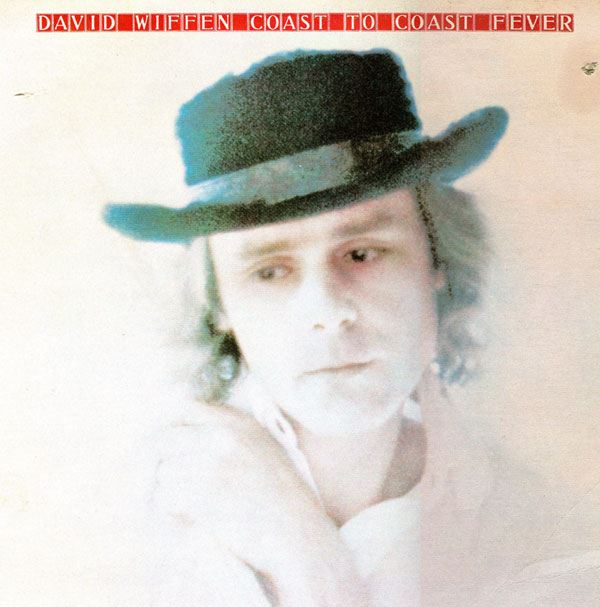
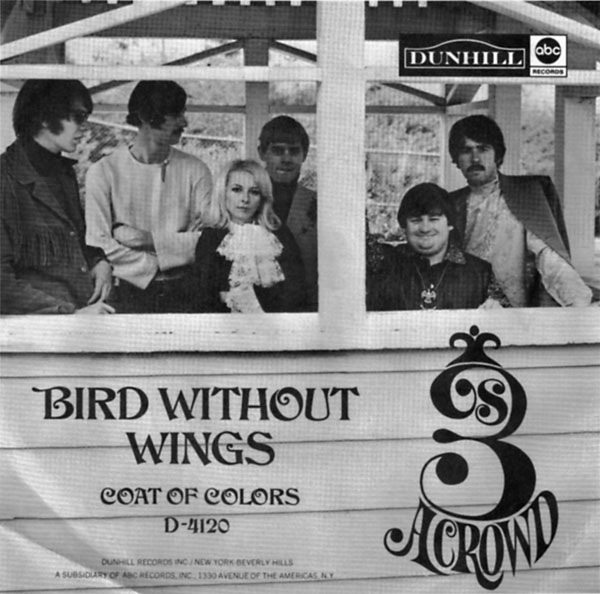
Ive looked for the rest of the songs on Christopher’s Movie Matinee but they dont seem to be available online. Any chance youll upload some more? Id be much obliged.
-Joe
Hello.
Anyone who’s interested should try:
http://redtelephone66.blogspot.com/search?q=A+Crowd
watch out when you try to download the lp . it gives you a virus !!
Now the site seems to be gone entirely.
Try googling: “Christopher’s Movie Matinee” rar
or: “Christopher’s Movie Matinee” zip
You’ll find several working download links. It’s a great record imo, I still listen to the LP 13+ years after I found copy thanks to a local college radio station dumping their vinyl (fools). Now off to track down those non-LP cuts. Jeff’s Lost Jukebox series contains a couple.
The album can be found here:http://www.emusic.com/album/3s-a-crowd/christophers-movie-matinee/13326380/
check the music video of the original folk trio, 3’s A Crowd in Vancouver in 1965 doing the Phil Ochs & Bob Gibson song, That’s The Way It’s Gonna Be
https://www.youtube.com/watch?v=O48KBW-Tj3s
on the Utube channel – King Anderson Art Videos
3’s A Crowd w/ Bruce Cockburn “Electrocution of the Word”, nice psychedelia!
https://www.youtube.com/watch?v=QAG1fOeA32E&ab_channel=unpopulararts
and also this CBC video for Let’s Get Together
https://www.youtube.com/watch?v=UfAlIWFNee4&ab_channel=brucster99b
Thanks so much for this article. I have a copy of the Dunhill “Bird Without Wings” and was listening to it this past week. It got me wondering about the group and the members. I’m so impressed with Donna Warner’s vocals and the harmonies. I looked on Wilkapedia which led me to this article. Again, thanks so much. Skip Conner, Piqua, Ohio
Does anyone have any information about the group called 3’s A Crowd who released the single “Keep On Walking/No Where” on Golden Voice Record? Their profile is not even mentioned on the Golden Voice website.
They were from Springfield, Illinois. Bob Cellini, Roger Humphrey and Mike Bertucci. The 45 was released in Apr ’67.
Correction: The Springfield, IL group’s first single “Making Do” on Ro-Do was released in Apr ’67. Their second single, “Keep On Walking / No Where,” was released in 1968.